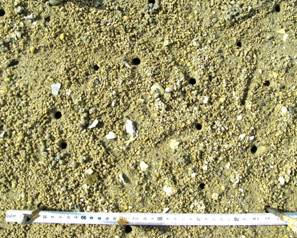|
Research Theme |
|
|
|
**************************************************************************************************** Promotional effects of macrofauna on
the tidal flat meiofauna: In tidal flat sediments, larger invertebrates often modify the sedimentary environment in such a way that smaller animals become more abundant, namely, macrofauna promote meiofauna. Ocypodid crabs are common macrofauna on tidal flats. While their foraging behavior gives negative impacts on meiofauna in top sediments, their burrows attract some meiofaunal taxa in deeper sediment layers. Some crabs may contribute to maintain biodiversity of infauna with their burrows. Little is known, however, about spatial changes in meiofaunal community structures on smaller scales around the burrows of ocypodid species in the sediments. On an intertidal
sandflat, Amakusa islands, southwestern (1) The impacts of feeding by crabs would be stronger on tidal flats nearer to their burrows. Thus, the abundance of some organisms in the top sediment would increase with the increase of distance from the burrows. (2) Their burrows, on the other hand,
would supply oxygen or food to the deeper parts of the sediments and make
environments favored by infauna around them. Some taxa would increase in the
sediments surrounding the burrows. |
|
|
|
|
|
**************************************************************************************************** Spatiotemporal changes in
community structure of deep-sea harpacticoids, and their associations with
environmental factors: “Why is local diversity so high on deep-sea floor?” Although knowledge about high species richness at local scale on the deep-sea floor has increased since the late 1960s, mechanisms to maintain such high diversity in the deep-sea environments, which is seemingly uniform, are still obscure (Gage and Tyler 1991). We have investigated spatial and temporal changes in species
diversity and structure of deep-sea harpacticoids (Fig.2), and their
associations with environmental factors, in order to reveal processes
maintaining high species diversity of organisms on the deep-sea floor. |
|
|
|
|

